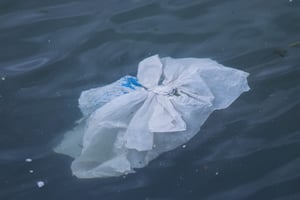BY JEFF KIRBY
Communities across the world have been moved to action by growing awareness of the terrible global problems caused by throwaway plastic.
 In the UK, the natural history TV series Blue Planet II, with its distressing images of marine animals entangled in or ingesting plastic waste, was a major wake-up call. It prompted petitions to government, direct action at supermarkets, and a consumer backlash against single-use plastic items in retail packaging.
In the UK, the natural history TV series Blue Planet II, with its distressing images of marine animals entangled in or ingesting plastic waste, was a major wake-up call. It prompted petitions to government, direct action at supermarkets, and a consumer backlash against single-use plastic items in retail packaging.
However much it is part of the fabric of our daily lives, plastic takes a long time to decompose and, as a pollutant, leaches toxic chemicals into soil and water which harm human, animal and plant life.
When it comes to ensuring safe drinking water for humans, the World Health Organisation (WHO) is demanding that water suppliers and regulators prioritise the removal of microplastics alongside other chemicals and bacteria.
This approach, coupled with years of citizen-led campaigning, informs the European Commission’s reformed Drinking Water Directive.
Its aim is to make tap water safer through tighter quality standards during treatment. These include setting minimum water quality requirements, and regular monitoring and testing of chemical pollutants and bacteriological indicators.
An evaluation of the previous directive on water quality, in line with WHO scientific data, has resulted in 18 new or revised limits being proposed for microbiological, chemical and indicator parameters.
One of the most important changes is the new mandatory measurement of turbidity, the extent to which water is cloudy, opaque or thick with particles or contaminant.
Turbidity is typically calculated in NTUs, or Nephelometric Turbidity Units, measured by for example, how much a light source is reduced in strength when it passes through a water sample.
The previous indicator level at the consumer point of use, the tap in other words, was less than one NTU. Now is it less than 0.3. If the supplier or regulator is out of specification on this measure, and does not act on it, they are breaking the law.
The tighter rule reflects recognition of the importance of low turbidity in ensuring the effective disinfection of water. Anything above 0.3 is now deemed too high to guarantee trouble-free disinfection at the water treatment facility.
WHO recommendations state: ‘The important role of turbidity in controlling filtration performance and ensuring efficacy of disinfection should be made much clearer and also the requirement that turbidity should be as low as reasonably achievable.’ While the revised value may seem onerous to some water providers, the WHO guidelines state that it should easily be achievable with a properly designed and maintained system.
This, in truth, is a clarion call for the wider use of depth cartridge filters. Unlike those that work at the surface, depth filters capture contaminants and organic matter through the total thickness of the filter.
At Amazon Filters, we fully support the aim of improving the quality of drinking water and giving consumers more protection and confidence through stricter parameters, monitoring and testing.
We have recently worked with a number of UK municipal water providers to attain the revised turbidity levels set out in the new directive and can report no issues on filtration efficiency or lifetime.
For more than 30 years, our housings, filters and bespoke skid and containerised systems have been successfully processing water in applications to improve turbidity. As well as microplastics, these include the removal of sand, silt, organic material and precipitated metals, and the control of cryptosporidium. We aim to provide maximum flexibility depending on client need.
To ensure you stay on the right side of the new EU rules on turbidity, talk to us about your filtration requirements.
 In the UK, the natural history TV series Blue Planet II, with its distressing images of marine animals entangled in or ingesting plastic waste, was a major wake-up call. It prompted petitions to government, direct action at supermarkets, and a consumer backlash against single-use plastic items in retail packaging.
In the UK, the natural history TV series Blue Planet II, with its distressing images of marine animals entangled in or ingesting plastic waste, was a major wake-up call. It prompted petitions to government, direct action at supermarkets, and a consumer backlash against single-use plastic items in retail packaging.